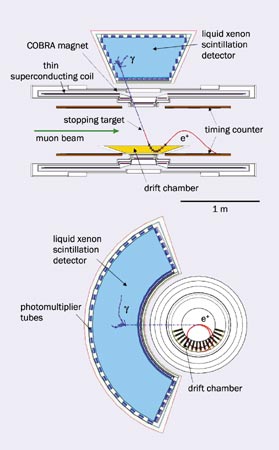The 30th anniversary of the proton accelerator complex at PSI heralds the start of a new generation of particle-physics experiments, with the search for the decay of the muon to a positron and a photon.

This year marks 30 years of successful operation of the 590 MeV proton accelerator complex at Switzerland’s national user laboratory, the Paul Scherrer Institut (PSI) in Villigen. Originally designed for proton currents of 100 µA, the ring cyclotron is now routinely producing beam currents of close to 2 mA. This megawatt beam is the progenitor of the world’s most intense direct current (DC) pion and muon beams and makes possible the measurement of rare decays and the search for “classical” forbidden decays. If found, the latter would signal new physics and allow access to these phenomena in a regime complementary to that possible with high-energy colliders.
PSI has a long tradition in this field, especially in searches for lepton-flavour violation (LFV); some of the most competitive limits in the charged lepton sector stem from the laboratory’s high-intensity muon beams. Notable examples of such searches are for µ → 3e, µ → e conversion and muonium (µ+e–) → anti-muonium (µ–e+) conversion. Although all of the results so far are still limits, the next generation of charged LFV searches may promise more. Recent results from the neutrino sector – for example at Super-Kamiokande, SNO and KamLAND – demonstrate flavour-changing processes in the realm of neutral leptons, which are associated with non-zero neutrino mass. There is also a continued interest in the results from the Muon g-2 Collaboration at Brookhaven.
While in simple extensions to the Standard Model the interesting rates are prohibitively small, in supersymmetric extensions (SUSY) and especially in grand-unified theories (SUSY-GUT) – which turn out to be particularly favourable to LFV – the branching ratios are predicted to lie only one to two orders of magnitude lower than the present experimental bounds. In particular, compared with other LFV processes, such as µ → 3e, µ → e conversion in a nucleus and τ → eγ, the decay process µ → eγ is expected to have a higher sensitivity to supersymmetric unification. A new generation of LFV searches is therefore now in preparation, notably the MEG experiment (µ+ → e+γ search) at PSI and MECO (µ → e conversion search) at Brookhaven.
The MEG collaboration, comprised of some 50 members from 11 institutes in Italy, Japan, Russia and Switzerland, is currently commissioning the initial part of the beam line, as well as the first detector components, which have already arrived at PSI. The ambitious goal of this experiment is to achieve a single-event sensitivity for the decay µ+ → e+γ that will be more than two orders of magnitude lower than the current best limit on the branching ratio µ+ → e+γ < id= 1.2 x 10sup>-11, achieved by the MEGA collaboration at the Los Alamos Meson Physics Facility (LAMPF).
For the MEG detector to be able to distinguish the coincident back-to-back µ+ → e+γ events at a high rate from the main combinatorial background of normal and radiative muon decays, a high-current DC duty-cycle machine, such as the Ring Cyclotron at PSI, combined with the highest intensity surface muon beam is a prerequisite. On the detection side, two main components – an 800 litre liquid xenon (LXe) photon calorimeter using scintillation light together with a gradient-field, thin-coil superconducting positron spectrometer – make possible the required energy/momentum, spatial and timing resolutions.

The gradient magnetic field of the COBRA (Constant Bending-Radius) spectrometer allows the decay positrons to execute spiral paths of constant projected bending radius and increasing axial pitch, which depend entirely on the particle’s total momentum while being independent of its emission angle. This allows a background of lower energy Michel positrons to be swept away more effectively from the fiducial tracking volume of the azimuthally spaced, staggered-cell drift chambers. Timing information and hence trigger information for events is provided by a set of fast, double-layered, orthogonally placed timing-counter arrays, positioned at either end of the magnet.
The LXe photon calorimeter, which is viewed from all sides by some 800 photomultiplier tubes (PMTs) immersed in the cryogenic fluid, allows a homogeneous measurement of the energy, spatial and timing co-ordinates of the photon. A milestone in the development of the calorimeter was recently achieved with beam tests in Japan and at PSI. A large prototype detector with about one-tenth of the volume and 228 PMTs has yielded a preliminary value of better than 4.5% full width at half maximum for the energy resolution at 55 MeV, as well as a position-dependent spatial resolution, σ, of 2-4 mm, demonstrating that the required resolutions can be achieved.
The R&D phase for MEG is now slowly drawing to a close and the production phase is beginning to gain impetus. Initial engineering runs are planned during 2005, with full detector assembly expected for the end of 2005. Data taking will start in 2006, almost 60 years after the first attempt by E P Hincks and Bruno Pontecorvo to see what was then known as a “meson” decay to an electron and photon, using cosmic rays. Naturally, we hope not to measure “zero”!
Further reading
http://meg.web.psi.ch.





